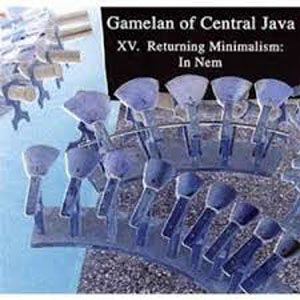 The subtitle of this disc, “Returning Minimalism,” denotes a key fact about twentieth-century American minimalism: it makes extensive use of the formal elements of gamelan. The circular structures, repetitive melodies, intricate rhythms, and incremental modulations of tone are all hallmarks of the music of such American composers as Terry Riley, Philip Glass, Steve Reich, La Monte Young, and John Adams through at least part of their careers. (While minimalism is not quite as dominant a school as some might think, references and traces show up in the work of composers as diverse as Lou Harrison, Michael Nyman, and Harry Partch, to name just a few.) As Daniel Patrick Quinn notes in his essay, there are other roots of this American hybrid, of course — jazz, twelfth-century plainsong, classical raga, African drumming — but the basic structures and the sound are so strongly reminiscent of gamelan that it was only a matter of time, I suppose, until someone thought to investigate gamelan’s reaction to minimalism. Thus, Returning Minimalism: In Nem.
The subtitle of this disc, “Returning Minimalism,” denotes a key fact about twentieth-century American minimalism: it makes extensive use of the formal elements of gamelan. The circular structures, repetitive melodies, intricate rhythms, and incremental modulations of tone are all hallmarks of the music of such American composers as Terry Riley, Philip Glass, Steve Reich, La Monte Young, and John Adams through at least part of their careers. (While minimalism is not quite as dominant a school as some might think, references and traces show up in the work of composers as diverse as Lou Harrison, Michael Nyman, and Harry Partch, to name just a few.) As Daniel Patrick Quinn notes in his essay, there are other roots of this American hybrid, of course — jazz, twelfth-century plainsong, classical raga, African drumming — but the basic structures and the sound are so strongly reminiscent of gamelan that it was only a matter of time, I suppose, until someone thought to investigate gamelan’s reaction to minimalism. Thus, Returning Minimalism: In Nem.
The first track, In Nem “Seven”, built on phrases composed by Al Suwardi, is remarkable first for its clarity: each voice seems to be set off in its own space, and while they blend to give a rich texture, one can follow individual threads with ease. It’s hypnotic, as is so much gamelan, so much so that the introduction of new voices almost causes one to jump.
In Nem “Four”, on phrases by Joko Purwanto, begins in similar fashion to the previous track, with a rapid, simple, and very precise pulse, around which various voices build variations on the basic phrases. This one is somewhat denser in texture, although it still maintains clarity, and equally hypnotic, although the trance music feeling takes a bit longer to establish itself.
In Nem “One”, a product of group improvisation, establishes quite a different character from the very beginning: the pulse is established by a melody rather than percussion at the start, a phrase with quite a definite end, and there is a readily audible drone. Voices appear and disappear (much like, as it happens, the visual dynamic of watching a Steve Reich or Philip Glass concert in the late 1970s, as musicians suddenly joined in the activity and just as suddenly sat back). This was the first track recorded in the session, and as Quinn notes, it has a free, exploratory quality that is immediately appealing. It also sounds to me the most like many of the early serial minimalist works I remember from the 1970s and ’80s. I think this one is my favorite — it has the greatest range of sounds, including passages that almost sound as though singers were involved, and the richest colors and textures.
I’m sitting here listening as I’m writing, and one thing that I find faintly humorous is that it sounds like gamelan and I have to really think about the connections between the music I’m hearing and its Western model — in this recording, as it happens, that was Terry Riley’s In C, often credited as the beginning of minimalism in music. (Maybe I’ve just been listening to too much Indonesian music.) It is, as Quinn also points out, an improvisational take-off inspired by In C rather than a straight interpretation. (Although that certainly would not be impossible — In C is specifically designed to be open to a range of performances practices. I’ve heard versions by a Chinese orchestra, a mariachi band, and a rock group.) Consequently, the works are all titled In Nem, “nem” being the word for note six, the note common to both pelog and slendro scales in the gamelan set that was used in these performances.
I also found this review extraordinarily difficult to write, I think for one main reason: the music is so hypnotic that I kept getting lost in it and forgetting to write about it. Take that as you will.
You can start our reviews of this series here.
(Felmay, 2011)
